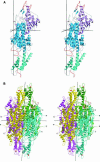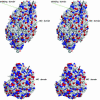Structural basis for the entrance into the phenylpropanoid metabolism catalyzed by phenylalanine ammonia-lyase
- PMID: 15548745
- PMCID: PMC535883
- DOI: 10.1105/tpc.104.025288
Structural basis for the entrance into the phenylpropanoid metabolism catalyzed by phenylalanine ammonia-lyase
Abstract
Because of its key role in secondary phenylpropanoid metabolism, Phe ammonia-lyase is one of the most extensively studied plant enzymes. To provide a basis for detailed structure-function studies, the enzyme from parsley (Petroselinum crispum) was crystallized, and the structure was elucidated at 1.7-A resolution. It contains the unusual electrophilic 4-methylidene-imidazole-5-one group, which is derived from a tripeptide segment in two autocatalytic dehydration reactions. The enzyme resembles His ammonia-lyase from the general His degradation pathway but contains 207 additional residues, mainly in an N-terminal extension rigidifying a domain interface and in an inserted alpha-helical domain restricting the access to the active center. Presumably, Phe ammonia-lyase developed from His ammonia-lyase when fungi and plants diverged from the other kingdoms. A pathway of the catalyzed reaction is proposed in agreement with established biochemical data. The inactivation of the enzyme by a nucleophile is described in detail.
Figures








Similar articles
-
The essential tyrosine-containing loop conformation and the role of the C-terminal multi-helix region in eukaryotic phenylalanine ammonia-lyases.FEBS J. 2006 Mar;273(5):1004-19. doi: 10.1111/j.1742-4658.2006.05127.x. FEBS J. 2006. PMID: 16478474
-
Expanding the substrate scope of phenylalanine ammonia-lyase from Petroselinum crispum towards styrylalanines.Org Biomol Chem. 2017 May 3;15(17):3717-3727. doi: 10.1039/c7ob00562h. Org Biomol Chem. 2017. PMID: 28405665
-
Biochemical and Structural Analysis of Substrate Specificity of a Phenylalanine Ammonia-Lyase.Plant Physiol. 2018 Feb;176(2):1452-1468. doi: 10.1104/pp.17.01608. Epub 2017 Dec 1. Plant Physiol. 2018. PMID: 29196539 Free PMC article.
-
A modern view of phenylalanine ammonia lyase.Biochem Cell Biol. 2007 Jun;85(3):273-82. doi: 10.1139/o07-018. Biochem Cell Biol. 2007. PMID: 17612622 Review.
-
Friedel-Crafts-type mechanism for the enzymatic elimination of ammonia from histidine and phenylalanine.Angew Chem Int Ed Engl. 2005 Jun 13;44(24):3668-88. doi: 10.1002/anie.200461377. Angew Chem Int Ed Engl. 2005. PMID: 15906398 Review.
Cited by
-
Optimized condition for enhanced soluble-expression of recombinant mutant anabaena variabilis phenylalanine ammonia lyase.Adv Pharm Bull. 2014;4(3):261-6. doi: 10.5681/apb.2014.038. Epub 2014 Feb 7. Adv Pharm Bull. 2014. PMID: 24754010 Free PMC article.
-
Spatiotemporal transcriptomic atlas of rhizome formation in Oryza longistaminata.Plant Biotechnol J. 2024 Jun;22(6):1652-1668. doi: 10.1111/pbi.14294. Epub 2024 Feb 12. Plant Biotechnol J. 2024. PMID: 38345936 Free PMC article.
-
Highly Active and Specific Tyrosine Ammonia-Lyases from Diverse Origins Enable Enhanced Production of Aromatic Compounds in Bacteria and Saccharomyces cerevisiae.Appl Environ Microbiol. 2015 Jul;81(13):4458-76. doi: 10.1128/AEM.00405-15. Epub 2015 Apr 24. Appl Environ Microbiol. 2015. PMID: 25911487 Free PMC article.
-
Multiple tandem duplication of the phenylalanine ammonia-lyase genes in Cucumis sativus L.Planta. 2012 Oct;236(4):1093-105. doi: 10.1007/s00425-012-1659-1. Epub 2012 May 10. Planta. 2012. PMID: 22572777
-
In-depth Sequence-Function Characterization Reveals Multiple Pathways to Enhance Enzymatic Activity.ACS Catal. 2022 Feb 18;12(4):2381-2396. doi: 10.1021/acscatal.1c05508. Epub 2022 Feb 1. ACS Catal. 2022. PMID: 37325394 Free PMC article.
References
-
- Allwood, E.G., Davies, D.R., Gerrish, C., Ellis, B.E., and Bolwell, G.P. (1999). Phosphorylation of phenylalanine ammonia-lyase: Evidence for a novel protein kinase and identification of the phosphorylated residue. FEBS Lett. 457, 47–52. - PubMed
-
- Ambrus, C.M., Ambrus, J.L., Horvath, C., Pedersen, H., Sharma, S., Kant, C., Mirand, E., Guthrie, R., and Paul, T. (1978). Phenylalanine depletion for the management of phenylketonuria: Use of enzyme reactors with immobilized enzymes. Science 201, 837–839. - PubMed
-
- Appert, C., Zon, J., and Amrhein, N. (2003). Kinetic analysis of the inhibition of phenylalanine ammonia-lyase by 2-aminoindan-2-phosphonic acid and other phenylalanine analogues. Phytochemistry 62, 415–422. - PubMed
-
- Baedeker, M., and Schulz, G.E. (1999). Overexpression of a designed 2.2 kb gene of eukaryotic phenylalanine ammonia-lyase in Escherichia coli. FEBS Lett. 457, 57–60. - PubMed
-
- Baedeker, M., and Schulz, G.E. (2002. a). Autocatalytic peptide cyclization during chain folding of histidine ammonia-lyase. Structure 10, 61–67. - PubMed
Publication types
MeSH terms
Substances
Associated data
- Actions
- Actions
- Actions
- Actions
LinkOut - more resources
Full Text Sources
Other Literature Sources

